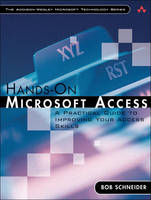
Hands-On Microsoft Access
Addison-Wesley Educational Publishers Inc (Verlag)
978-0-321-24545-8 (ISBN)
- Titel ist leider vergriffen;
keine Neuauflage - Artikel merken
Access is one of the most widely used pieces of software. Perhaps more so
than any other common program, such as Word or Excel, though, many of its
users find it more vexing to really understand and use well. This is because you
can't use Access successfully without a framework in your head of how a
relational database management system works, and almost none of us have that
training. While there are many books on Access, most of them are either
introductory tutorials on how to use Access's features, or big comprehensive
references. None of them give a good solid grounding in basic database design
principles. This book fills that need; there really is no other book on Access like
it on the market. The author has written for on Access for more than seven
years, and knows how to present complicated principles clearly and in an easyto-
understand way.
Bob Schneider has been a writer and editor for more than 25 years. Since 2001, he has been writing about Access for Smart Computing, one of the nations leading computer magazines. For three years he served as editor-in-chief of Working Smarter with Microsoft Access, a biweekly newsletter that helps office staff use Access more productively. Prior to that, he was development editor for Access 95, 97, and 2000 textbooks published by Glencoe/McGraw-Hill. He is based in San Francisco, CA.
Preface.
Acknowledgments.
About the Author.
1. Getting Started.
Key Terms
Data Types
Primary Keys
It's About Nothing: Null Values and Zero-Length Strings
Conclusion
2. Database Design.
Learning About Database Design
Getting Started
Midchapter Review
Relational Database Principles
Organizing Fields into Tables
Refine the Fields
Keys
Multivalue Fields
Conclusion
3. Understanding Relationships.
The Primacy of Primary Keys
One-to-Many Relationships
Many-to-Many Relationships
Final List of Fields and Relationships
Exclusive Identification
Refining Field Names
Table Types
What Is Normalization?
Conclusion
4. Establishing Relationships.
Viewing and Creating Relationships
Referential Integrity
Overriding Referential Integrity
The Mechanics of the Relationship Window
Test Data and Conclusion
5. Building Tables.
Understanding Lookup Fields
Creating Access Tables
Creating Fields
Assigning Field Properties
Making Changes to Tables and Fields
Table Properties
Conclusion
6. Entering, Editing, and Displaying Data.
Tables Are the Center of the Access Universe
Data Entry in Table, Form, and Query Datasheets
How Form Controls Inherit Field Characteristics
Data Entry Methods
Data Entry: Form Versus Substance
Conclusion
7. Find and Filter.
Find and Replace
Filters
Filters in Reports
Expressions
Conclusion
8. Queries.
The Nature of Queries
Building Queries
Adding Calculated Fields
Top Values Property
Multitable Queries
Relationships Versus Joins
Inner Versus Outer Joins
SQL
Updating Records in a Query
Find Duplicates Query Wizard
Conclusion
9. Queries, Part II.
Parameter Queries
Totals Queries
Crosstab Queries
Action Queries
Conclusion
10. Reports.
Learning How to Create Reports
The Asia Database
Begin the Report by Creating a Query
Beginning a Report in Design View
Detail Section
Page Header and Footer
Using Concatenation
Report Header and Footer
Creating a Report Using the Report Wizard
Comparing the From-Scratch and From-Wizard Reports
Conclusion
11. Forms/Subforms.
Form Overview
Exploring Form Tools
Using the Form Wizard
Refining Your Form
Conclusion
12. Form/Report Design Elements.
Adding Pictures and Other Objects
Visual Elements and Tools
Manipulating Controls
Macros
Multipage Forms
Switchboard Manager
Other Report Types
Conclusion
13. Importing and Exporting.
Import/Export Overview
Move Access Data to a Word Processor or Text Editor
Move Access Data to Excel
E-mail an Access Object
Import Access Data into Outlook
Importing Data into Access
Importing Access Data
Linking Versus Importing
Conclusion
14. Pivot Tables and Pivot Charts.
Getting Started with Pivot Tables
Pivot Tables Using Queries
Pivot Table Properties
Creating Pivot Charts
Conclusion
Glossary.
Index.
| Erscheint lt. Verlag | 8.9.2005 |
|---|---|
| Verlagsort | New Jersey |
| Sprache | englisch |
| Maße | 234 x 179 mm |
| Gewicht | 744 g |
| Themenwelt | Mathematik / Informatik ► Informatik ► Datenbanken |
| Informatik ► Office Programme ► Access | |
| ISBN-10 | 0-321-24545-8 / 0321245458 |
| ISBN-13 | 978-0-321-24545-8 / 9780321245458 |
| Zustand | Neuware |
| Informationen gemäß Produktsicherheitsverordnung (GPSR) | |
| Haben Sie eine Frage zum Produkt? |
aus dem Bereich


